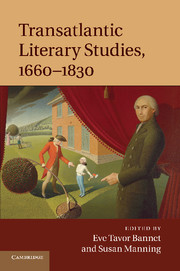Book contents
- Frontmatter
- Contents
- Notes on contributors
- Acknowledgements
- Introduction: British and American genres
- Chapter 1 Transatlantic books and literary culture
- Chapter 2 Transatlantic utopianism and the writing of America
- Chapter 3 Tales of wonder, spiritual autobiographies, and providence tales
- Chapter 4 Life writings
- Chapter 5 Benjamin Franklin and transatlantic literary journalism
- Chapter 6 Theatre, drama, performance
- Chapter 7 Transatlantic American Indians
- Chapter 8 Literature of the ocean
- Chapter 9 “To gird this watery globe”
- Chapter 10 Ghostly and vernacular presences in the black Atlantic
- Chapter 11 Susanna Rowson and the transatlantic captivity narrative
- Chapter 12 Domestic fiction and the reprint trade
- Chapter 13 Transatlantic Gothic
- Chapter 14 Transatlantic Romanticisms
- Chapter 15 Journeys of the imagination in Wheatley and Coleridge
- Chapter 16 Transatlantic historical fiction
- Further reading
- Index
- References
Chapter 13 - Transatlantic Gothic
Published online by Cambridge University Press: 05 January 2012
- Frontmatter
- Contents
- Notes on contributors
- Acknowledgements
- Introduction: British and American genres
- Chapter 1 Transatlantic books and literary culture
- Chapter 2 Transatlantic utopianism and the writing of America
- Chapter 3 Tales of wonder, spiritual autobiographies, and providence tales
- Chapter 4 Life writings
- Chapter 5 Benjamin Franklin and transatlantic literary journalism
- Chapter 6 Theatre, drama, performance
- Chapter 7 Transatlantic American Indians
- Chapter 8 Literature of the ocean
- Chapter 9 “To gird this watery globe”
- Chapter 10 Ghostly and vernacular presences in the black Atlantic
- Chapter 11 Susanna Rowson and the transatlantic captivity narrative
- Chapter 12 Domestic fiction and the reprint trade
- Chapter 13 Transatlantic Gothic
- Chapter 14 Transatlantic Romanticisms
- Chapter 15 Journeys of the imagination in Wheatley and Coleridge
- Chapter 16 Transatlantic historical fiction
- Further reading
- Index
- References
Summary
American Gothic
While book history suggests that transatlantic Gothic was a singular phenomenon, albeit with regional differences, separate critical traditions have grown up largely dealing with Gothic on both sides of the Atlantic in isolation from each other. Early on, critics of American literature tended to minimize the Gothic by arguing that such generic features were the mere surface of the work, the important quality being the underlying “power of blackness”; or they argued the reverse, with the proviso that the genre that mattered was not Gothic, but “romance.” A recent trend has been to reject the question of genre entirely, on the grounds that “genre criticism” continues “to resist historical readings.” In his History of American Gothic, Charles Crow dramatically illustrates the upshot of this historical turn, by inverting Hawthorne's familiar complaint that novel-writing was inconceivably difficult in a land uncomplicated by “picturesque and gloomy wrong.” Hawthorne protests too much, says Crow, for, self-evidently, America suffered, not from a scarcity of history of the gloomy and sanguinary kind, but from a surfeit, starting with genocide and slavery – the kind of history that provided the reason for writing Gothic in the first place. Recent critics echo Louis S. Gross's claim that American Gothic ought to be read as a “demonic history text” and Leslie Fielder's that American Gothic constantly rewrites “a masterplot of cultural authority and guilt” arising from the “ambiguity of our relationship with Indian and Negro.” This version of the “return of the repressed” is based on the logic of abjection. In order to build itself up, ideologically, into a unified nation constructed out of republican idealism, the inchoate nation's criminal transgressions – its enslavement of blacks and extermination of natives – needed to be thrown down, and abjected; an act of self-ridding largely known through the fractal expressions of Gothic romance, with its dark conceits. Thus Erik Savoy argues that “the gothic is most powerful, and most distinctly American, when it strains toward allegorical translucency” (p. 6). With its dark matter made darker by an ideological dispensation to ignore it, American Gothic is troubled by an especially fraught tension between the countervailing push/pull of expression and denial, ending in a peculiar degree of ambiguity and opacity.
- Type
- Chapter
- Information
- Transatlantic Literary Studies, 1660–1830 , pp. 202 - 218Publisher: Cambridge University PressPrint publication year: 2011
References
- 2
- Cited by



